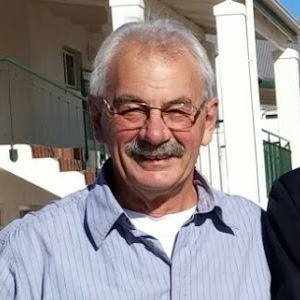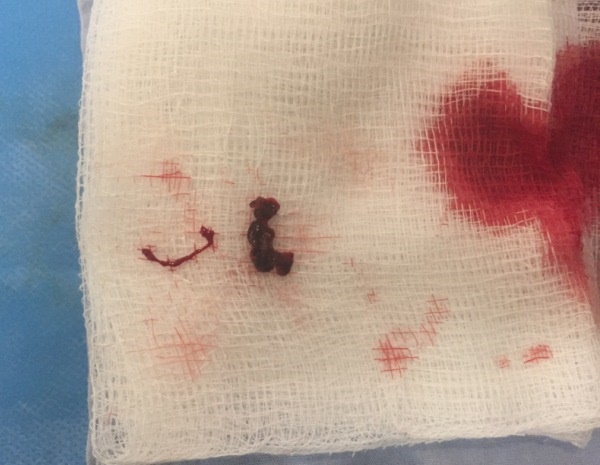
Gerald Williams from Somerset West, Cape Town considers himself a very lucky man after an ideal set of circumstances and the work of a well-coordinated expert team enabled Gerald to return to work three days after what would have been a devastating stroke that would have left him either severely disabled or dead.
Gerald suffered an ischaemic stroke, the most common type of stroke that occurs when a clot obstructs a blood vessel supplying blood to the brain. Gerald suffers from atrial fibrillation (irregular heartbeat) which caused a clot (embolus) to form in his heartwhich was transported to his brain, resulting in a complete blockage of his right internal carotid artery – the blood vessel that supplies three fifths of the right side of his brain (right cerebral hemisphere). If the clot was not removed, most of the right side of his brain would have died leaving him with severe disabilities such as paralysis on the left side, unable to speak and unable to work out even simple tasks.
Gerald explains what happened that Friday night:
"I was woken up by my wife at approximately 11:00 pm because I was thrashing around in the bed. My leg had fallen over the edge of the bed and I was struggling to pull it back up. I remember her telling our son to quickly call an ambulance as "Dad was having a stroke".
"I tried telling her that I was NOT having a stroke but my speech was very slurred. I can also remember holding my left arm with my right hand and asking her if it was HER arm as there was no sensation or feeling in it. It was then that I realised that I was paralysed down my entire left side (later my wife told me that the whole left side of my face was also skew)."
Gerald was experiencing typical symptoms of a stroke and his wife assessed him using the F.A.S.T test.
F.A.S.T stands for:
- Facial drooping
- Arm limp
- Speech disturbed
- Time - every minute counts
The ambulance arrived within twenty minutes and Gerald was rushed to Vergelegen Mediclinic which, fortunately, is located just five minutes away from his home.
"During those 20 minutes, my wife phoned some of our doctor friends as well as my Heart Specialist, Mark Abelson. By the time I got to the hospital, they were waiting for me and I was rushed into the scanning room."
Dr. Mark Abelson is a renowned cardiologist currently based at Vergelegen Mediclinic. After performing a brain scan on Gerald, he identified the embolism and rushed Gerald to the cardiac catheterisation theatre. Here, whilst Gerald was under local anaesthetic, Dr. Abelson inserted a stent retriever through the artery of Gerald's right leg to gain access to the blocked artery in his brain.
He managed to remove the clot using the stent retriever, successfully unblocking the artery. As a result, Gerald made a "dramatic and complete recovery."
Read: The signs and symptoms of a stroke

The clot removed from Gerald's brain. Source: Dr Abelson, Vergelegen Mediclinic, Somerset West
Ordinarily, patients in a similar situation to Gerald are not so lucky. Dr. Abelson explains that the prognosis in these cases is usually very poor:
"Up to 50% of patients presenting as Gerald did die within the first few days to weeks and just about all the survivors suffer from significant neurological fall-out / symptoms. This is even with the use of the currently recommended treatment of intravenous thrombolytics used in an attempt to dissolve the clot / embolism blocking the artery."
The procedure performed on Gerald, known as mechanical embolectomy through the use of a stent retriever, has a higher success rate in this specific scenario:
"In cases with complete internal carotid artery occlusion thrombolysis is only successful in 10% of cases. Whereas mechanical embolectomy using a stent retriever is successful in opening the artery in up to 90% of cases. Of these patients, about half will have a very good clinical outcome and be able to function independently at 90 days as opposed to about only 10% of patients with the current usual management."
Vergelegen Clinic has been performing this form of mechanical embolectomy since 2007 and is currently the only medical facility in Africaperforming the procedure on an "as-needed" basis in all acute stroke patients. It is offered at Groote Schuur Hospital to a very few stroke patients. To date, Dr. Abelson has treated nearly 200 strokes using this procedure:
"Of course not every case has as good an outcome as Gerald did – but he is not an exceptional case – I have had other patients have as dramatic an improvement in symptoms - if not more so!"
Dr. Abelson is part of a stroke team at Vergelegen Mediclinic that includes stroke physician Dr. Johan Roos, emergency unit staff, radiology and the nursing staff of the cardiac intensive care unit. Ordinarily, Dr. Roos would attend to and refer all stroke patients but he was away at the time of Gerald's stroke.
He goes on to explain that, in an ideal situation, the mechanical embolectomy procedure shouldn't be performed by a cardiologist:
"The issue of a cardiologist doing this work is controversial – it should be ideally be done by a radiologist or neurosurgeon trained in neuro-intervention – but we do not have such a person in Somerset West and therefore I do this procedure in a desperate bid to help an extremely unwell patient who will invariable have a poor outcome if this treatment was not offered."
Gerald's remarkable recovery
Gerald does not remember much from the procedure except that he experienced an intense pain behind his right eye whilst Dr. Abelson attempted to remove the clot. He explains:
"I think he told me that it took something like 3 tries before he managed to get it out. Literally within MINUTES of him removing the clot, all feeling came back to me. I was taken off to the ICU ward and by the time I woke up the next morning, I was feeling great – so much so that I wanted to go home! They kept me in for another day and I went home on the Sunday morning – less than two days after being admitted. Up to now, touch wood, I have had no after effects."
Gerald went on to make a full recovery and, looking back, considers himself very lucky for a number of reasons:
"My wife was supposed to be in Durban that weekend but decided at the last minute not to go – if she had gone I would most probably be dead now! I am also lucky that Mark was on hand and not doing some mountain bike trip somewhere, that he was available to get to the hospital immediately."
Gerald hopes that his story will help bring recognition to the procedure:
"If I am able, in any way, to help get the procedure recognised and performed by other doctors in South Africa, I will be a very happy chappie. Without the treatment, even if I had survived, I would most probably have be confined to a wheelchair, paralysed and blind, which would not only have been dreadful for me, but also for my family and friends!"
Read: What is feels like to experience a stroke
Getting help immediately
Gerald's complete recovery is largely the result of such a rapid response. His wife knew the warning signs of a stroke and quickly took action once she had realised what was happening. As a result of this, the ambulance arrived within 20 minutes, Gerald arrived at the hospital within 45 minutes and the clot had been identified and removed within two hours of the onset of the stroke.
When someone is having a stroke every minute counts. The earlier the patient can be treated, the lower their risk of death or serious complications including physical disability and brain damage.
Preventing the stroke in the first place
Atrial Fibrillation (AF) is one of the many risk factors that increase the chances of one having a stroke. AF is thought to be the cause of about 15% of all strokes, but having AF increases the risk of stroke 500% compared to patients without AF, and is the cause of severe strokes.
Medications – known as anticoagulants or “blood thinners” – are recommended for patients with AF. These treatments are highly effective at preventing strokes but should be used with caution and are only available following a prescription from your doctor.
Two classes of these anticoagulants are available. Warfarin is the current standard of care to prevent strokes in patients with AF. Certain limitations of warfarin such as; frequent drug level testing, diet alterations and increased bleeding risk prevent patients from remaining compliant to the regimen, leaving patients at risk.
Newer age drugs are now available, worldwide and in South Africa, that do not require monitoring or diet adjustments.
If you or a family member have AF, speak to your doctor about getting the most appropriate stroke prevention medication as a priority.
Find out: What to do if someone is having a stroke
Articles by Dr Abelson have been published in the Cardiovascular Journal of Africa, Catheterization and Cardiac Intervention and more recently, in the Journal of American College of Cardiology earlier this month.
Read more:
Stroke is a leading killer of South Africans
Sensitivity to salt puts black South Africans at risk
Salt is killing South Africans




 Publications
Publications
 Partners
Partners
















